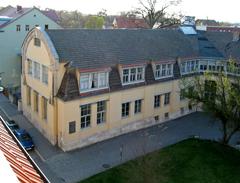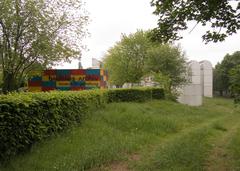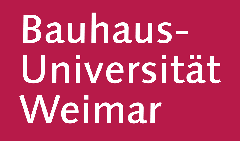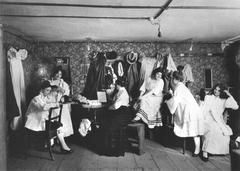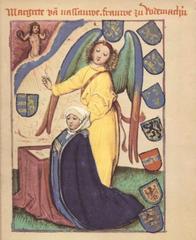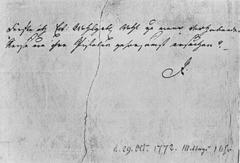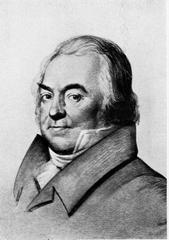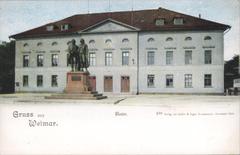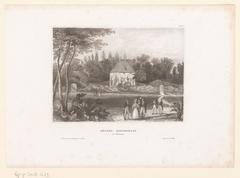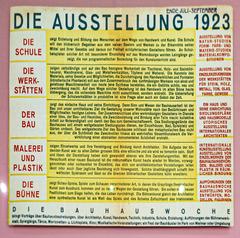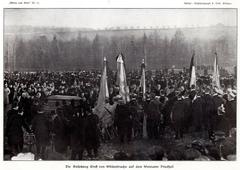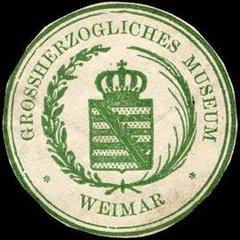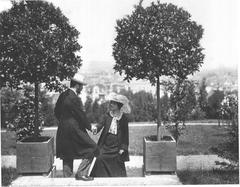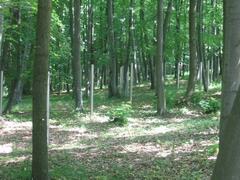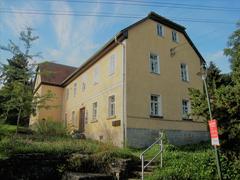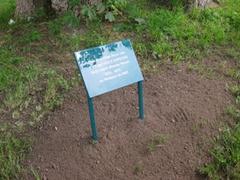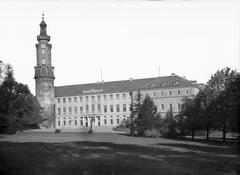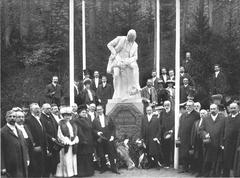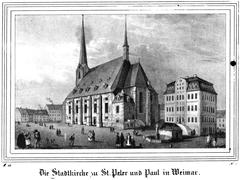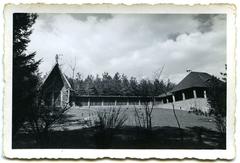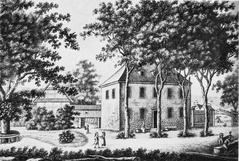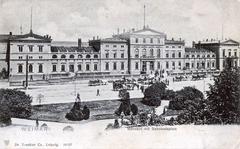
Haus Hohe Pappeln: Visiting Hours, Tickets, and Historical Significance in Weimar
Date: 04/07/2025
Introduction
Haus Hohe Pappeln, located in Weimar, Germany, stands as an iconic representation of early 20th-century modernist architecture. Designed and constructed between 1907 and 1908 by Belgian architect Henry van de Velde—a pivotal figure in the Art Nouveau (Jugendstil) movement—the villa embodies the Gesamtkunstwerk philosophy, where architecture, interior design, furnishings, and landscape are conceived as an integrated whole. Serving as van de Velde’s private residence during his tenure at the Grand-Ducal School of Arts and Crafts, Haus Hohe Pappeln became a key site in Weimar’s transformation into a center for progressive art and design, influencing the emergence of the Bauhaus (Klassik Stiftung Weimar; Bauhaus100).
This guide provides comprehensive visitor information—covering Haus Hohe Pappeln visiting hours, tickets, accessibility, and tours—while delving into its architectural features, cultural context, restoration history, and its vital role in Weimar’s heritage. Whether you are an architecture enthusiast, design historian, or a traveler seeking to immerse yourself in Weimar’s artistic legacy, this article will equip you with essential insights and practical tips for your visit.
Table of Contents
- Historical Context and Origins
- Architectural and Artistic Significance
- Cultural Impact and Legacy
- Visiting Haus Hohe Pappeln: Hours, Tickets, and Accessibility
- Guided Tours and Special Events
- Photography and Visitor Etiquette
- Nearby Attractions
- Restoration and Heritage Protection
- Key Dates and Figures
- Frequently Asked Questions (FAQ)
- Conclusion
- References
Historical Context and Origins
Haus Hohe Pappeln marks a turning point in Weimar’s cultural evolution. Designed as Henry van de Velde’s family home, its construction coincided with Weimar’s emergence as a hub for avant-garde art and design. Van de Velde, invited to Weimar in 1902 to direct the Grand-Ducal School of Arts and Crafts, played a central role in establishing the city’s reputation for artistic innovation (Klassik Stiftung Weimar). The name “Hohe Pappeln” (“High Poplars”) references the tall trees originally framing the property, emphasizing van de Velde’s appreciation for integrating architecture with nature.
The villa quickly became a meeting place for artists, writers, and intellectuals, fostering dialogues that shaped the direction of early 20th-century aesthetics. The house’s holistic design philosophy and its role as a cultural salon laid critical groundwork for the Bauhaus, founded a decade later in Weimar (Bauhaus Kooperation).
Architectural and Artistic Significance
Haus Hohe Pappeln is celebrated as a masterpiece of modern residential architecture. Van de Velde’s Gesamtkunstwerk approach is evident in every detail: the villa features an asymmetrical layout, white plastered façades, and horizontal bands of windows, all designed to maximize natural light and connect interior spaces with the surrounding garden (Iconic Houses). The interiors, including custom-built furniture, lighting, textiles, and even picture frames, reflect van de Velde’s commitment to unity of form and function.
Key features include:
- Salon (Living Room): The heart of the house, designed for gatherings and social life.
- Dining Room: Connected to the salon, featuring original or period-appropriate furnishings.
- Study: Restored to its original appearance, showcasing van de Velde’s mature style.
- Garden: Featuring the sculpture “Kniender Jüngling” by Georg Minne, seamlessly blending art and nature (Vielfalt der Moderne).
The villa’s rejection of historicist ornament, focus on material authenticity, and harmonious integration of all arts greatly influenced both the Deutscher Werkbund and the Bauhaus, solidifying its legacy in modern design (Werkbund).
Cultural Impact and Legacy
Beyond its architectural innovation, Haus Hohe Pappeln’s cultural significance is profound. As van de Velde’s residence, it became a center for creative exchange, attracting renowned contemporaries and nurturing the ideals that would define modernist design (Weimar.de). The house’s legacy is celebrated in exhibitions and research, remaining integral to Weimar’s identity as a UNESCO World Heritage city.
Visiting Haus Hohe Pappeln: Hours, Tickets, and Accessibility
Location
- Address: Belvederer Allee 58, 99425 Weimar, Germany
- Easily accessible via public transport (bus lines 1 or 12, stop: Papiergraben) or by foot/bike from the city center (Lonely Planet).
Visiting Hours
- Wednesday to Monday: 10:00 AM – 6:00 PM (Late March to early November)
- Closed Tuesdays and in winter
- Note: The house will be closed for major restoration from June 2, 2025, until at least 2027 (Klassik Stiftung Weimar).
Ticket Prices
- Adults: €5.00
- Reduced (students, youth): Discounted rates
- Children under 16: Free
- ModerneCard (€17.00): Access to multiple modernist sites in Weimar
- Tickets can be booked online or onsite.
Accessibility
- Ground floor: Accessible with assistance (rollator); entrance steps may require support.
- Upper floors: Not wheelchair accessible due to historic structure.
- Contact the museum in advance for specific support (klassik-stiftung.de).
Guided Tours and Special Events
Guided tours are occasionally available, offering in-depth exploration of the villa’s history, architecture, and van de Velde’s design philosophy. Tours are primarily in German; English tours may be arranged in advance (germanyfootsteps.com). Audio guides and special exhibitions enhance the visitor experience; check the official website for schedules and languages.
Photography and Visitor Etiquette
- Photography: Permitted in exterior and garden areas. Interior photography is generally restricted; inquire with staff upon arrival.
- Etiquette:
- No eating or drinking inside the house.
- Do not touch original furnishings or exhibits.
- Supervise children and maintain respectful behavior.
Nearby Attractions
Haus Hohe Pappeln is close to several Weimar historical sites, ideal for a cultural itinerary:
- Bauhaus Museum Weimar
- Goethe’s Garden House
- Schloss Belvedere
- Goethe National Museum
- Duchess Anna Amalia Library
Combine sites for a deeper understanding of Weimar’s artistic and architectural heritage (ibnbattutatravel.com; germanyfootsteps.com).
Restoration and Heritage Protection
Haus Hohe Pappeln has undergone extensive restoration to return its interiors and garden to van de Velde’s original vision. After periods of neglect and modification, major campaigns in the 1990s and again from 2013–2016 focused on reconstructing lost features and reinstating authentic materials, colors, and furnishings (Vielfalt der Moderne; Iconic Houses). The Klassik Stiftung Weimar, with public and private funding, oversees ongoing preservation, ensuring the site’s future as a museum and cultural monument (Klassik Stiftung Weimar).
Key Dates and Figures
- 1902: Van de Velde arrives in Weimar.
- 1907–1908: Construction of Haus Hohe Pappeln.
- 1917: Van de Velde departs; the house changes ownership.
- 1985: Listed as a historic monument.
- 2003: Opened as a museum by Klassik Stiftung Weimar.
- 2012: Full acquisition by the foundation.
- 2013–2016: Major restoration of interiors and garden.
- 2025–2027: Scheduled closure for further restoration.
Frequently Asked Questions (FAQ)
Q: What are the current visiting hours?
A: Wednesday to Monday, 10:00 AM – 6:00 PM (March–November). Closed Tuesdays and during winter. Closed from June 2, 2025, for restoration.
Q: How much are tickets?
A: €5.00 for adults, concessions available, children under 16 free.
Q: Is Haus Hohe Pappeln accessible?
A: Ground floor is accessible with assistance; upper floors are not.
Q: Are guided tours available in English?
A: Occasionally, by arrangement. Check the official website.
Q: Can I take photographs inside?
A: Generally restricted indoors; ask staff for permission.
Conclusion
Haus Hohe Pappeln is more than a historic villa; it is a living testament to the vision of Henry van de Velde and a cornerstone of Weimar’s cultural and architectural heritage. Through meticulous restoration and ongoing conservation, visitors today can experience an authentic Gesamtkunstwerk—where design, art, and daily life merge seamlessly. Plan your visit by checking up-to-date hours and tickets on the Klassik Stiftung Weimar website, and enrich your journey with guided tours, nearby attractions, and digital resources like the Audiala app.
Explore Haus Hohe Pappeln to witness the origins of modern design and immerse yourself in Weimar’s vibrant artistic legacy.
References and Further Reading
- This guide synthesized information from:





